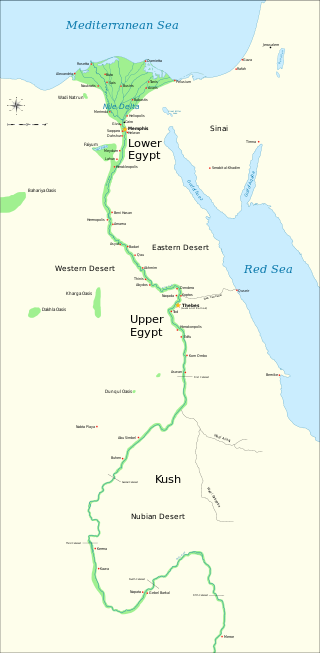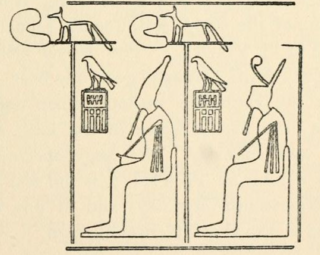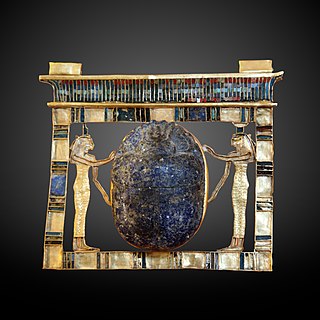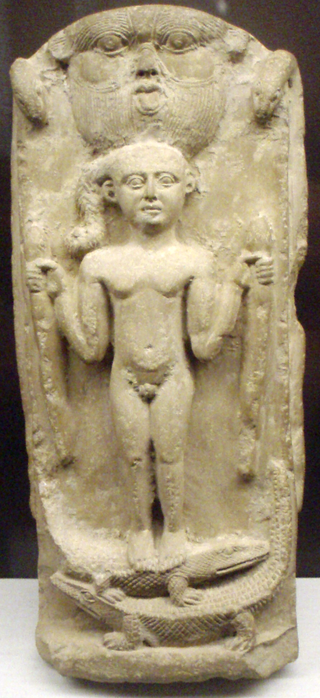
The First Intermediate Period, described as a 'dark period' in ancient Egyptian history, spanned approximately 125 years, c. 2181–2055 BC, after the end of the Old Kingdom. It comprises the Seventh, Eighth, Ninth, Tenth, and part of the Eleventh Dynasties. The concept of a "First Intermediate Period" was coined in 1926 by Egyptologists Georg Steindorff and Henri Frankfort.

Kamose was the last Pharaoh of the Theban Seventeenth Dynasty. He was possibly the son of Seqenenre Tao and Ahhotep I and the brother of Ahmose I, founder of the Eighteenth Dynasty. His reign fell at the very end of the Second Intermediate Period. Kamose is usually ascribed a reign of three years, although some scholars now favor giving him a longer reign of approximately five years.

Djer is considered the third pharaoh of the First Dynasty of ancient Egypt in current Egyptology. He lived around the mid 31st century BC and reigned for c. 40 years. A mummified forearm of Djer or his wife was discovered by Egyptologist Flinders Petrie, but was discarded by Émile Brugsch.

Userkare Khendjer was a minor king of the early Thirteenth Dynasty of Egypt during the Middle Kingdom. Khendjer possibly reigned for four to five years, archaeological attestations show that he was on the throne for at least three or four years three months and five days. Khendjer had a small pyramid built for himself in Saqqara and it is therefore likely that his capital was in Memphis.

The was sceptre is a symbol that appeared often in relics, art, and hieroglyphs associated with the ancient Egyptian religion. It appears as a stylized animal head at the top of a long, straight staff with a forked end.

Abusir is the name given to an ancient Egyptian archaeological pyramid complex comprising the ruins of 4 kings' pyramids dating to the Old Kingdom period, and is part of the Pyramid Fields of the Memphis and its Necropolis UNESCO World Heritage Site.

Shepsesre Tefnakht was a prince of Sais and founder of the relatively short Twenty-fourth Dynasty of Egypt; he rose to become a Chief of the Ma in his home city. He is thought to have reigned roughly 732 BCE to 725 BCE, or seven years. Tefnakht I first began his career as the "Great Chief of the West" and Prince of Sais and was a late contemporary of the last ruler of the 22nd Dynasty: Shoshenq V. Tefnakht I was actually the second ruler of Sais; he was preceded by Osorkon C, who is attested by several documents mentioning him as this city's Chief of the Ma and Army Leader, according to Kenneth Kitchen, while his predecessor as Great Chief of the West was a man named Ankhhor. A recently discovered statue, dedicated by Tefnakht I to Amun-Re, reveals important details about his personal origins. The statue's text states that Tefnakht was the son of a certain Gemnefsutkapu and the grandson of Basa, a priest of Amun near Sais. Consequently, Tefnakht was not actually descended from either lines of Chiefs of the Ma and of the Libu as traditionally believed but rather came from a family of priests, and his ancestors being more likely Egyptians rather than Libyans.

Hedjkheperre Setepenre Takelot I was an ancient Libyan ruler who was pharaoh during the Twenty-second Dynasty of Egypt.

Hedjkheperre Setepenre Smendes was the founder of the Twenty-first Dynasty of Egypt and succeeded to the throne after burying Ramesses XI in Lower Egypt – territory which he controlled. His Egyptian nomen or birth name was actually Nesbanebdjed meaning "He of the Ram, Lord of Mendes", but it was translated into Greek as Smendes by later classical writers such as Josephus and Sextus Africanus. According to the Story of Wenamun from c. 1000 BC, Smendes was a governor of Lower Egypt during the Era of the Renaissance under the reign of Ramesses XI, however, Egyptologists have questioned the historical accuracy of this story.

Aakheperre Shoshenq V was an ancient Egyptian pharaoh of the late 22nd Dynasty.

Sekhemre Seusertawy Sobekhotep VIII was an ancient Egyptian ruler during the Second Intermediate Period whose exact chronological placement remains uncertain. He may have ruled over the Theban region in Upper Egypt. Scholars debate whether he belonged to the 13th, 16th, or 17th Dynasty. If Sobekhotep VIII was a king of the 16th Dynasty, it is thought that he is listed in the Turin Canon (11:2), which credits him with a 16-year reign.

The Department of Ancient Egypt is a department forming an historic part of the British Museum, with Its more than 100,000 pieces making it the largest[h] and most comprehensive collection of Egyptian antiquities outside the Egyptian Museum in Cairo.

Paser was an ancient Egyptian noble who served as vizier during the reigns of Seti I and Ramesses II in the 19th Dynasty. He would later also become High Priest of Amun.

The High Priest of Ptah was sometimes referred to as "the Greatest of the Directors of Craftsmanship". This title refers to Ptah as the patron god of the craftsmen.

The ancient Egyptian noble Prehotep II was Vizier in the latter part of the reign of Ramesses II, during the 19th Dynasty.

The Twenty-fourth Dynasty of Egypt is usually classified as the fourth Dynasty of the Ancient Egyptian Third Intermediate Period.

Sekhemrekhutawy Pantjeny was an Egyptian pharaoh during the Second Intermediate Period. According to the Egyptologists Kim Ryholt and Darrell Baker, he was a king of the Abydos Dynasty, although they leave his position within this dynasty undetermined. Alternatively, Pantjeny could be a king of the late 16th Dynasty. According to Jürgen von Beckerath, Pantjeny is to be identified with Sekhemrekhutawy Khabaw, whom he sees as the third king of the 13th Dynasty.
Thutmose was an ancient Egyptian vizier under Amenhotep III, during the 18th Dynasty.

The Stela of Pasenhor, also known as Stela of Harpeson in older literature, is an ancient Egyptian limestone stela dating back to the Year 37 of pharaoh Shoshenq V of the 22nd Dynasty. It was found in the Serapeum of Saqqara by Auguste Mariette and later moved to The Louvre, where it is still.

Horus on the Crocodiles is a motif found on ancient Egyptian healing amulets from the Third Intermediate Period until the end of the Ptolemaic dynasty, as well as on larger cippi and stelae. Both the portable amulets and the larger statues are sometimes referred to simply as Horus stelae.



















